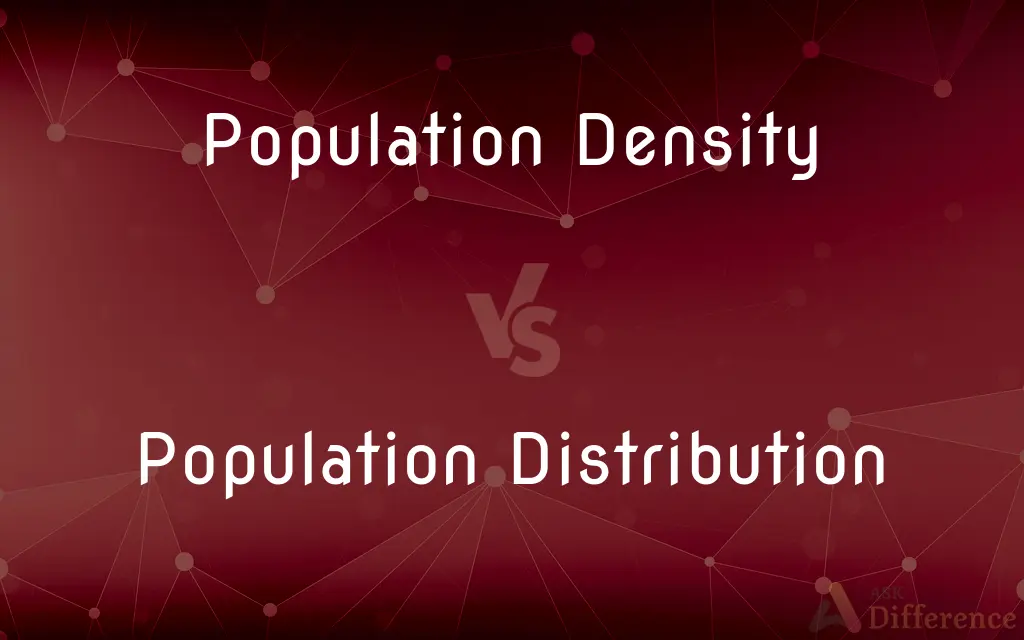Population Density vs. Population Distribution — What's the Difference?
By Tayyaba Rehman — Published on November 19, 2023
Population Density is the number of people per unit area, while Population Distribution describes how those people are spatially arranged within that area.

Difference Between Population Density and Population Distribution
Table of Contents
ADVERTISEMENT
Key Differences
Population Density refers to the concentration of people in a particular area. This metric provides a numerical value, typically individuals per square mile or kilometer. It offers a straightforward measurement, suggesting how crowded or sparse an area might be.
Population Distribution, on the other hand, elucidates the spatial arrangement of people across a specific region. This concept does not just denote the number of inhabitants but indicates where exactly they reside, whether clustered, evenly spread, or dispersed.
Population Density can provide insights into the potential strain or demand on resources and infrastructure. High densities often relate to urban centers and might indicate areas with bustling activities, potential traffic, and more.
In contrast, Population Distribution can unveil patterns influenced by various factors, such as geography, climate, or job availability. Understanding distribution is crucial for urban planning, revealing areas where amenities, roads, or services might be needed most.
While Population Density presents a quantifiable figure, Population Distribution paints a more detailed picture of human settlement patterns, giving context to the numbers. Both are invaluable in demography, geography, and planning fields.
ADVERTISEMENT
Comparison Chart
Definition
Measures the number of people per unit area.
Describes the spatial arrangement of people in an area.
Units of Measurement
Typically people per square mile or square kilometer.
Qualitative descriptions like clustered, dispersed, or even.
Interpretation
Indicates how crowded an area is.
Indicates where people choose to live within an area.
Key Factors
Birth rate, death rate, migration.
Physical geography, job opportunities, infrastructure.
Utility
Helps gauge pressure on resources.
Useful for urban and regional planning.
Compare with Definitions
Population Density
A count of people per square mile or square kilometer in a region.
The Population Density of Alaska is sparse, making it one of the least dense states.
Population Distribution
The spatial arrangement of people within a specific area.
The Population Distribution in Australia is clustered along the coasts.
Population Density
A metric revealing how crowded or sparse a particular region is.
Rural areas often have a lower Population Density compared to cities.
Population Distribution
The layout of human settlements, from clustered cities to dispersed rural areas.
Population Distribution in the U.S. Midwest shows both dense cities and spread-out farmlands.
Population Density
The concentration of individuals within a specific land area.
With a Population Density of 27,000 people per square mile, Manhattan is highly concentrated.
Population Distribution
A map-based representation of where inhabitants reside within boundaries.
Population Distribution maps of Canada reveal a majority residing near the southern border.
Population Density
The ratio of people to the size of the land they inhabit.
As urbanization increases, the Population Density of many cities is on the rise.
Population Distribution
How inhabitants are spread out over a region, whether evenly or unevenly.
The Population Distribution in the Sahara Desert is very sparse due to its harsh conditions.
Population Density
The number of inhabitants per unit of geographic space.
The Population Density of the U.S. is relatively low compared to many Asian countries.
Population Distribution
The geographic pattern of where people live.
Mountains and valleys significantly influence the Population Distribution in Switzerland.
Common Curiosities
Why is Population Density important?
It helps in understanding the concentration of people in an area, which can impact resources, infrastructure, and policy-making.
What factors influence Population Distribution?
Physical factors (like climate and topography), economic opportunities, political conditions, and social factors can influence where people live.
What is Population Density?
Population density refers to the number of people living per unit of an area, often per square kilometer or square mile.
Can an area have a high Population Density but an uneven Population Distribution?
Yes. For instance, a city might have a high overall density, but people may cluster in certain neighborhoods and avoid others.
What's a common unit for measuring Population Density?
People per square kilometer (pp/km^2) or people per square mile (pp/mi^2) are common units.
How is Population Distribution visually represented?
Often through maps that show concentrations of populations in different areas, using shades or colors.
Can an area's Population Density change over time?
Absolutely. As people migrate, birth rates change, or infrastructural developments occur, population densities can rise or fall.
How do Population Density and Distribution differ?
While density gives a numeric value of people per unit area, distribution describes the spatial arrangement of those people.
Is a high Population Density always indicative of overcrowding?
Not necessarily. While high density can mean overcrowding, it can also reflect efficient use of space in well-planned areas.
What is Population Distribution?
It describes how people are spatially spread across a specific area, whether dispersed, clustered, or evenly distributed.
What challenges arise from uneven Population Distribution?
Areas with high concentrations may face resource shortages, while sparsely populated areas might lack essential services.
Does Population Distribution affect urban planning?
Yes. Knowing where people live helps city planners decide where to place infrastructure, services, and amenities.
How does technology impact Population Distribution?
Technological advancements can make remote areas more livable or attractive for business, influencing where people choose to live.
Can natural disasters affect Population Distribution?
Yes. Disasters can lead to migration, altering the distribution in affected and neighboring areas.
Is there a perfect Population Density for an area?
No "one-size-fits-all" number exists. Optimal density varies based on resources, infrastructure, and the preferences of the population.
Share Your Discovery

Previous Comparison
DNS vs. DHCP
Next Comparison
Whatman Filter Paper vs. Normal Filter PaperAuthor Spotlight
Written by
Tayyaba RehmanTayyaba Rehman is a distinguished writer, currently serving as a primary contributor to askdifference.com. As a researcher in semantics and etymology, Tayyaba's passion for the complexity of languages and their distinctions has found a perfect home on the platform. Tayyaba delves into the intricacies of language, distinguishing between commonly confused words and phrases, thereby providing clarity for readers worldwide.












































